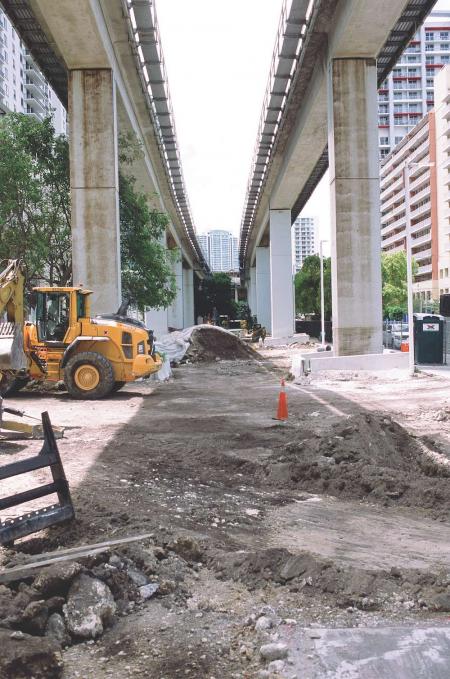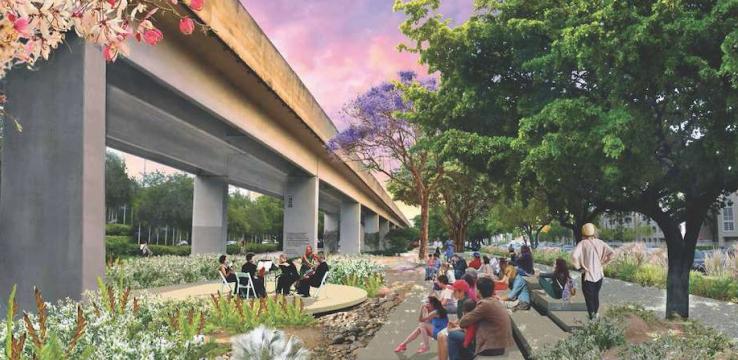There’s a national movement within cities to invest in public spaces and civic commons as a way to promote both social connection and economic growth. Miami has fully embraced this strategy with the Underline, an innovative project spurred by community residents who saw the opportunity to repurpose 120 acres of open space into a 10-mile-long park.
James Corner Field Operations, an urban design and landscape architecture firm best known for its work on New York’s High Line, is working to transform the unpleasant dead space under the Metrorail line into a natural gateway to link communities from downtown Miami to the southern neighborhoods in Dadeland. This multimodal corridor will connect neighborhoods, promote walking, biking and transit, catalyze transit-oriented development (TOD), enhance the natural environment and offer options for outdoor living beyond the city’s world-class beaches.
Florida is the most dangerous state for cyclists, and Miami has the dubious distinction of being the fourth most dangerous place for pedestrians in the U.S.. With that firmly in mind, Meg Daly, founder of the Underline, saw an opportunity to reorient the city’s car-centrism by building the proper social infrastructure to facilitate a dramatic shift in both attitude and behavior.
The effort has been completely resident-driven and over the past five years has garnered the support of multiple municipalities. Miami, Coral Gables, South Miami and the Village of Pinecrest unanimously endorsed the project, citing the potential positive economic impact to their respective communities and the health benefits for the nearly 400,000 residents within a 10-minute walk of the park and trail.
During SPUR’s Miami study trip, we got to meet with Meg Daly and her team. Here’s some of what we learned.
Change-makers with big ideas move fast in Miami
The Underline has a compelling origin story: In 2013, Daly broke both of her arms and couldn’t drive. To get to physical therapy, she took Metrorail near her home and walked underneath the train tracks to her destination. Even in the heat of summer, she found relief in the shade of the tracks — but noticed she was the only one walking there. She realized that the land could be used as a linear park and urban trail, which led to the creation of the Underline.
Highways have divided neighborhoods for decades. In Miami, the highway has separated residents along socioeconomic and demographic lines. The Underline aims to reconnect neighborhoods; it invites people to come together and take advantage of the assets offered beyond their neighborhood borders. As the project comes to life, residents will see better outcomes in public health, recreation and urban reforestation. The project has made significant progress in a short amount of time due to its successful efforts to grow an active volunteer and ambassador program through its nonprofit group, Friends of the Underline.

Working with the community to create something for the community
The Underline has deliberately involved residents in a community-based placemaking process, tapping University of Miami student teams to gather community feedback through meetings, surveys, canvasing at grocery stores and other engagement events. The Field Operations team engaged in a master planning process to create a multimodal corridor with dedicated paths for walkers, joggers and bicyclists. Similar to the High Line, the Underline will feature a succession of eight “rooms” located under eight Metrorail stations with different themes and amenities designed to engage all members of the community. Construction along the first half-mile of the project is being accompanied by early activation through a variety of programming for all ages, including biking, yoga and other activities. Longer-term activation plans include a dog park, an outdoor gym, gaming tables and a promenade with a community stage. Plans also call for a significant amount of public art. The recently released public art master plan includes early projects funded by $2 million in development fees that have already been collected. Artist Bo Droga has converted simple drab concrete pillars into a fun depiction of a favorite Miami pastime, dominoes. The Underline is taking an inclusive approach to economic impact by choosing to rezone land after the project is developed, in the hopes that residents can participate in the process and benefit from the improvements. The Underline is also exploring how best to support local small businesses to ensure local economic benefit. Two Opportunity Zones1 along the Underline will help to drive investment along the corridor. The multiple benefits of the Underline, from public health to congestion relief by bolstering transit ridership, have translated into significant public support. Over $90 million of the $100 million raised (out of a $121 million total budget) has come from the public sector. The construction cost of $14.25 million for phase one has been covered through contributions from the State of Florida, the Florida Department of Transportation, Miami-Dade County and the City of Miami. Friends of the Underline will also raise $10 million to fund long-term operations, and the organization hopes to create an endowment of $20 million over five years. At press time, it was announced that Knight Foundation made a $925,000 investment in the technology infrastructure of the project. What’s remarkable is how quickly this has this all been accomplished. In just four years, The Underline has gone from vision to design to construction. Meg Daly’s leadership and deep history in civic work have helped advance the project in a way that is authentic to Miami and its residents. The team has also learned directly from projects like the High Line and the Atlanta BeltLine. The Underline is an exciting example of public agencies fully embracing the importance and impact public spaces can have on a growing community.
Endnotes
1 Opportunity zones are identified within economically distressed communities, where new investment may be eligible for preferential tax treatment.

